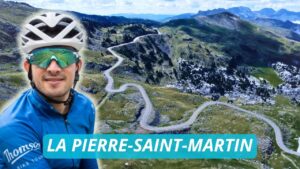THE MOST HOSTILE CLIMB OF THE GIRO D’ITALIA – PASSO GAVIA with Off The Marc!
Source: Off The Marc! Youtube Channel: THE MOST HOSTILE CLIMB OF THE GIRO D’ITALIA – PASSO GAVIA
Video THE MOST HOSTILE CLIMB OF THE GIRO D’ITALIA – PASSO GAVIA with Off The Marc !
Video THE MOST HOSTILE CLIMB OF THE GIRO D’ITALIA – PASSO GAVIA with Marc Figueras Grabulosa from Off The Marc YouTube Channel.
THE MOST HOSTILE CLIMB OF THE GIRO D’ITALIA – PASSO GAVIA
Paso Gavia: Climbing the Roof of the Giro d’Italia
When you take on the challenge of climbing Paso Gavia, you are met with formidable obstacles – big slopes, high altitude, and a lengthy climb. Add to that the unpredictable weather, and you’ve got yourself a true test of endurance. Welcome to the roof of the Giro d’Italia, Paso Gavia, located in Lombardia, an area known for its cycling passion and fervor.
16 kilometers to go and reaching an altitude of 2600 meters, the climb up Paso Gavia is not for the faint of heart. With an average gradient of eight percent, this 16.5-kilometer ascent presents a serious challenge to even the most seasoned cyclists. As you reach this point, the landscape transforms into a picturesque scene with narrow roads and steep switchbacks, setting the stage for the journey ahead.
Contrary to popular belief, the construction of the Paso Gavia road was a continuous process from bottom to top. Initially introduced in the Giro d’Italia in the 1960s as a gravel road, it underwent various revamps before finally being paved with asphalt in 2000. Despite its more recent additions to the Giro d’Italia, Paso Gavia has only made six appearances in the race due to its notorious weather conditions.
Paso Gavia may seem like paradise with its serene lakes and captivating views, but don’t be fooled. With an altitude of 2600 meters, the weather can transform this paradise into a freezing hell. The 1988 Giro d’Italia stage encountered the wrath of Paso Gavia when the cyclists had to face freezing temperatures and snowfall. Despite the adverse conditions, the race was not suspended, leading to a challenging and often perilous descent for the cyclists.
As the ascent continues and altitude breaks the 2000-meter mark, the landscape undergoes a dramatic change. Vegetation and trees begin to disappear, and a sense of vertigo sets in as the road becomes a balcony, clinging to the cliffside. The astounding view of the mountains and picturesque valley below, combined with the challenges of the climb, makes the journey up Paso Gavia a truly unforgettable experience.
The notorious tunnel on the route up Paso Gavia is a defining feature. Dark and seemingly endless, the tunnel was constructed over 40 years ago after a tragic bus accident on the old road. This tragedy led to the demise of 20 people and prompted the construction of this tunnel to improve safety for future travelers. The tunnel serves as a poignant reminder of the dangers and risks associated with the climb up Paso Gavia.
After 16.5 grueling kilometers of climbing, reaching an altitude of 2652 meters, the top of Paso Gavia is a sight to behold. The sense of accomplishment is overwhelming as you take in the stunning landscape from Ponte di Legno. The nearby Refugio Bonetta, operated by the Bonetta family since the 1950s, provides a welcome respite for cyclists, offering hot beverages and sweet treats to replenish their energy after the challenging ascent.
In conclusion, the ascent up Paso Gavia is both a physical and mental test, pushing cyclists to their limits and rewarding them with breathtaking views and a sense of achievement at the top. For those seeking a challenging yet rewarding climb, Paso Gavia is an experience unlike any other. It’s a testament to the resilience and determination of cyclists in the face of nature’s unforgiving elements. So, if you’re up for a challenge, Paso Gavia awaits, beckoning the boldest of cyclists to conquer its legendary slopes.
The opinions expressed in this space are the sole responsibility of the YouTube Channel Off The Marc! and do not necessarily represent the views of CicloNews.










